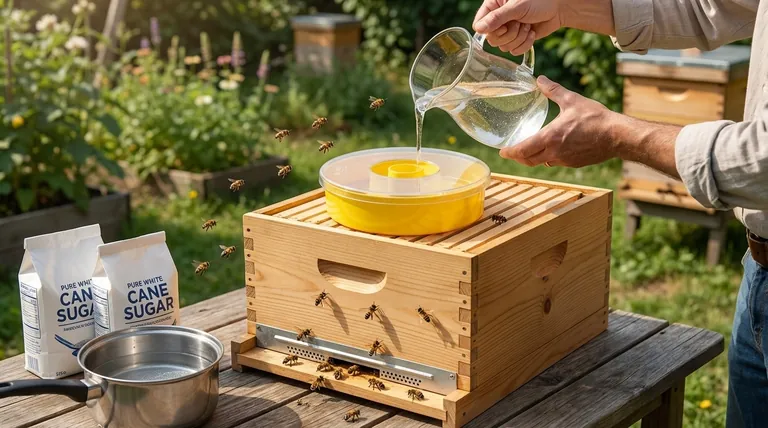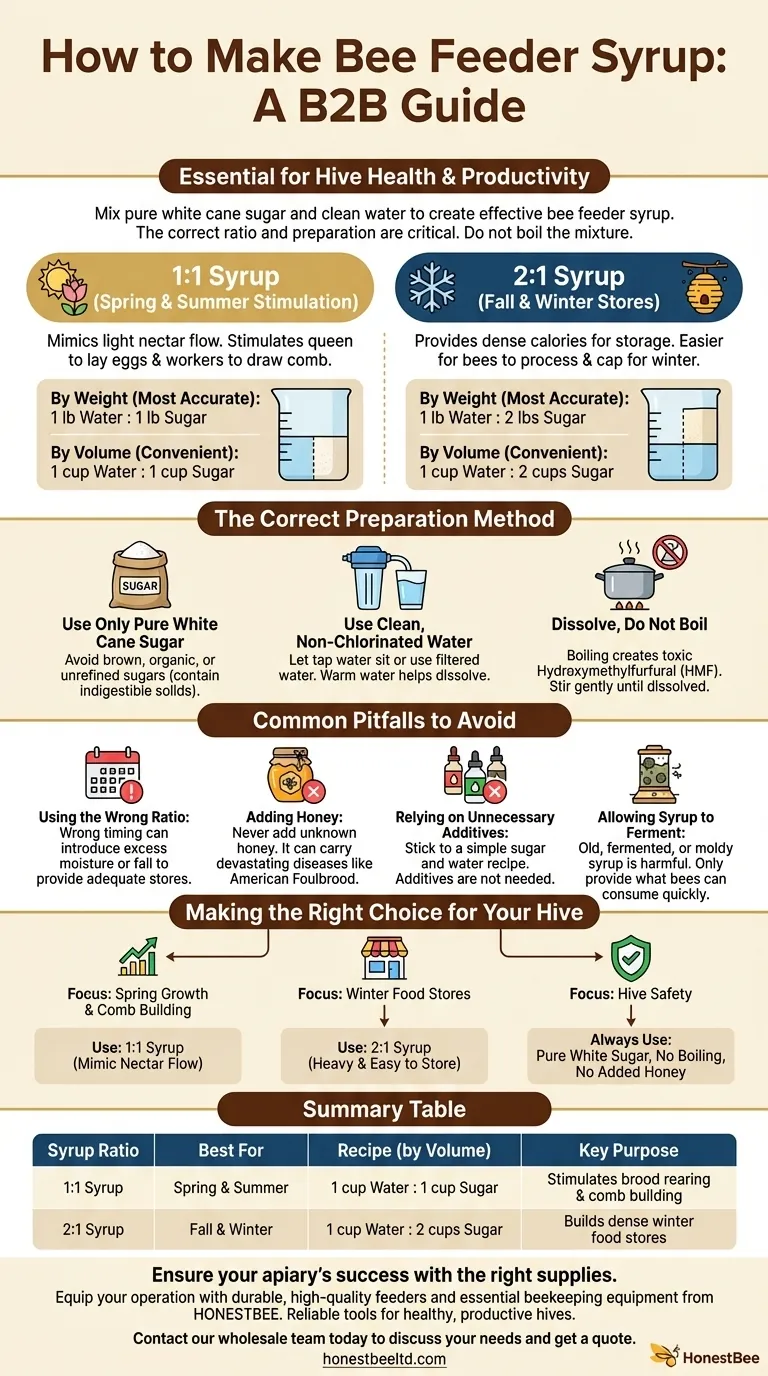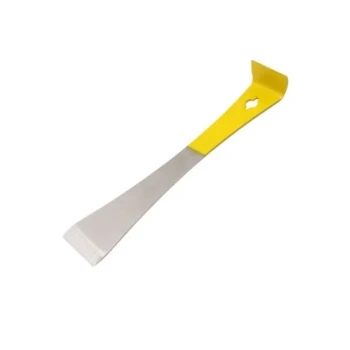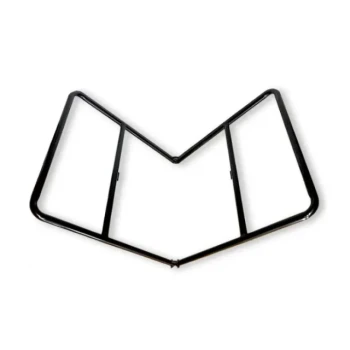To make bee feeder syrup, you will mix pure white cane sugar and water. The most common recipes are a 1:1 ratio (equal parts sugar and water by weight) for stimulating growth and a 2:1 ratio (two parts sugar to one part water by weight) for building winter food stores. It is critical to dissolve the sugar completely without boiling the mixture.
The specific ratio of sugar to water you use is not arbitrary; it is a strategic decision based on the time of year and your specific goal for the hive. Using the wrong ratio at the wrong time can be ineffective or even counterproductive.

The Two Essential Bee Syrup Ratios
The two foundational syrup recipes serve very different purposes in hive management. One mimics a light nectar flow to encourage activity, while the other provides dense calories for storage.
1:1 Syrup (Spring & Summer Stimulation)
This lighter syrup has a consistency similar to natural flower nectar. Bees consume it quickly, which stimulates the queen to lay more eggs and encourages workers to draw out new comb.
The standard recipe for 1:1 syrup is equal parts sugar and water by weight. A common approximation is using equal parts by volume.
- By Weight (Most Accurate): 1 pound of water mixed with 1 pound of sugar.
- By Volume (Convenient): 1 cup of water mixed with 1 cup of sugar.
2:1 Syrup (Fall & Winter Stores)
This thick, heavy syrup requires less work for the bees to process and store. They will reduce its water content and cap it in the comb, creating essential food reserves to survive the winter.
The recipe for 2:1 syrup is two parts sugar to one part water by weight.
- By Weight (Most Accurate): 1 pound of water mixed with 2 pounds of sugar.
- By Volume (Convenient): 1 cup of water mixed with 2 cups of sugar.
The Correct Preparation Method
How you prepare the syrup is just as important as the ratio you use. Improper ingredients or techniques can be harmful to your bees.
Use Only Pure White Sugar
Always use pure white cane sugar. Avoid brown sugar, organic sugar, or other unrefined sugars, as they contain solids that bees cannot digest, which can lead to dysentery.
Use Clean, Non-Chlorinated Water
Use clean, warm water to help the sugar dissolve. If your tap water is heavily chlorinated, it's best to let it sit out for 24 hours to allow the chlorine to evaporate or use filtered water.
Dissolve, Do Not Boil
Gently heat the water, but do not boil it. Add the sugar and stir until it is completely dissolved. Boiling sugar water can create a compound called Hydroxymethylfurfural (HMF), which is toxic to bees.
Common Pitfalls to Avoid
Successful bee feeding is about providing support while avoiding unintended harm. Understanding these common mistakes is critical for hive health.
Using the Wrong Ratio
Feeding a light 1:1 syrup in the late fall is a mistake. The bees will consume it for energy instead of storing it, and the high water content can introduce excess moisture into the hive at a critical time.
Adding Honey to Your Syrup
Never add honey from an unknown source (or even from your own hives, unless you are certain they are disease-free) to your syrup. Honey can carry spores of devastating diseases like American Foulbrood, which can easily infect and destroy your colony.
Relying on Unnecessary Additives
While some beekeepers add essential oils or other supplements, these are not necessary for effective feeding. For a new beekeeper, sticking to a simple, proven recipe of only sugar and water is the safest and most reliable approach.
Allowing Syrup to Ferment
Old syrup can ferment and grow mold, which is harmful to bees. Only put out an amount of syrup that the bees can consume within a few days, and be sure to clean your feeders thoroughly between uses.
Making the Right Choice for Your Hive
Your decision to feed, and what to feed, should always be intentional and based on the colony's needs.
- If your primary focus is stimulating spring growth and comb building: Use a 1:1 syrup to mimic a natural nectar flow.
- If your primary focus is helping bees build winter food stores: Use a heavy 2:1 syrup that is easier for them to process and store.
- If your primary focus is hive safety: Always use pure white cane sugar, never boil the syrup, and never add store-bought honey.
By understanding these principles, you can effectively support your bees and ensure their health and productivity.
Summary Table:
| Syrup Ratio | Best For | Recipe (by Volume) | Key Purpose |
|---|---|---|---|
| 1:1 Syrup | Spring & Summer | 1 cup water : 1 cup sugar | Stimulates brood rearing & comb building |
| 2:1 Syrup | Fall & Winter | 1 cup water : 2 cups sugar | Builds dense winter food stores |
Ensure your apiary's success with the right supplies.
Now that you know how to prepare the correct syrup, equip your operation with durable, high-quality feeders and other essential beekeeping equipment from HONESTBEE. We supply commercial apiaries and distributors with the reliable tools needed for healthy, productive hives.
Contact our wholesale team today to discuss your needs and get a quote.
Visual Guide

Related Products
- HONESTBEE Round Hive Top Bee Feeder for Syrup
- HONESTBEE Entrance Bee Feeder Professional Hive Nutrition Solution for Beekeeping
- Rapid Bee Feeder White Plastic 2L Round Top Feeder for 8 or 10-Frame Bee Hives
- Professional Hive Front Entrance Bee Feeder
- HONESTBEE Entrance Bee Feeder Efficient Hive Front Liquid Feeding Solution for Beekeeping
People Also Ask
- What are the features of top feeders for bees? Maximize Hive Health with Safe, High-Capacity Feeding
- What types of hive boxes is the round hive top feeder compatible with? Universal Fit for 8 & 10-Frame Langstroth Hives
- What features make top feeders a reliable choice for beekeepers? A Guide to Safe, Efficient Hive Nutrition
- What is the correct method for preparing sugar syrup for bees? Ensure Safe, Non-Toxic Feeding for Your Hives
- Why is a top feeder essential for bees? Ensure Colony Health and Efficiency



















